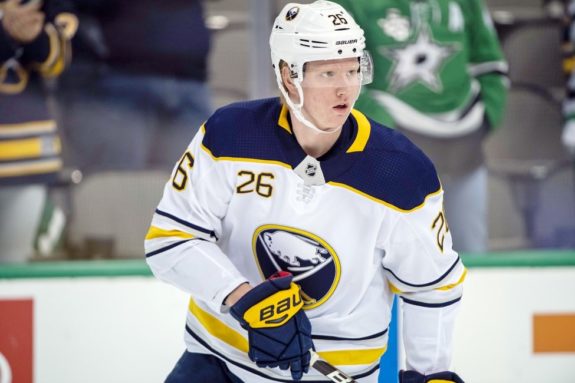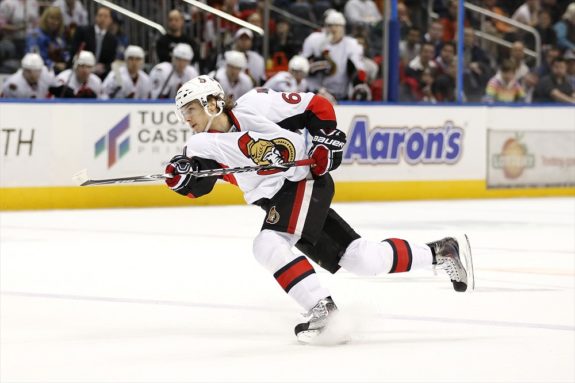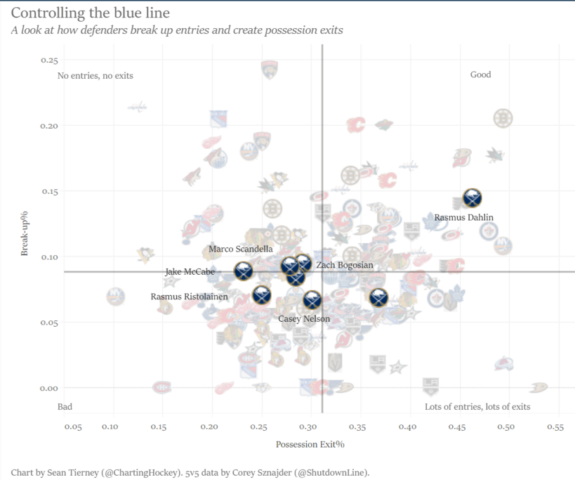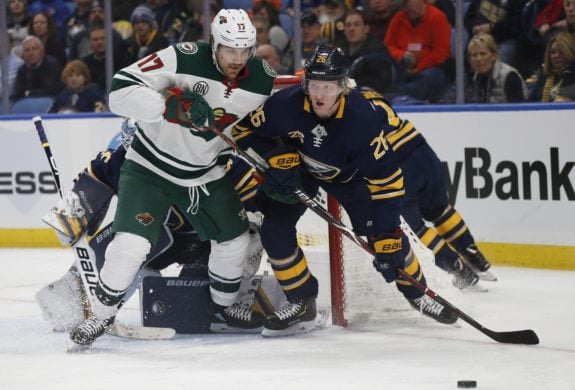There’s nothing like a good list to get the collective blood of hockey fans boiling in August.
The NHL just released its list of the top 20 defensemen currently in the league. While most fanbases certainly feel a level of consternation over one of their hometown heroes not making the cut, fans of the Buffalo Sabres have a particular bone to pick with the formulator of this list.
The complete lack of Rasmus Dahlin on this list is an abomination.
Some may reason that Dahlin’s having played only one season renders him ineligible for consideration. The thought process would be, “He has potential, sure, but he needs to prove himself before making this list.”
That thinking is all fine and good for most prospects. Dahlin is a different animal though. What he accomplished in his inaugural season and what he is poised to do in 2019-20 make him an absolute no-brainer addition to this list.
Add to that the fact that fellow rookie Miro Heiskanen made the cut at number 17, there is really no reason Dahlin is not on this list. I’ll say it here:Dahlin is a superior defenseman to Heiskanen! Let’s look at what he accomplished last season and what he is positioned to realize as early as this coming season.
Dahlin’s Offensive Rookie Season
Amid much fanfare, Dahlin entered his rookie season with remarkably high expectations. Anytime a player is picked first overall in the NHL Entry Draft, those expectations only make sense.
Dahlin’s case seemed different from most, though. Names like Nicklas Lidstrom, Victor Hedman and Erik Karlsson were being thrown around as comparables. Beyond the obvious Swedish connections, being mentioned in the same breath as these current and former legends could prove to be too much for some.
Did I mention Dahlin is a different animal?

As an 18-year-old, Dahlin produced an astounding 44 points. A defenseman that produces over a half point-per-game in today’s NHL is very valuable. Considering the fact that he finished with the second-most points ever by an 18-year-old defenseman, his rookie season could arguably be considered one of the best ever.
But let’s move beyond the context of his peers. How did Dahlin’s accomplishments compare to the rest of the league?
Dahlin Made the Most of Opportunities
Dahlin completed his rookie season 23rd in points among defensemen. He finished ahead of Alex Pietrangelo, P.K. Subban, Charlie McAvoy, Heiskanen and Colton Parayko while tying with Zach Werenski.
With regards to his deployment, Dahlin averaged 21:09 of ice-time per game. That ranked him 71st among defensemen. He also averaged 23.2 shifts per game which placed him 150th amongst defensemen. He was being deployed as a middle-to-bottom pairing defender but finished as a number one defenseman in terms of points.

There is more to being a top defender than scoring points though. How did Dahlin stack up in terms of his defense?
Dahlin’s Defensive Determination
While his offence is what may initially catch your eye, the one word that could truly personify Dahlin’s game is control. Whether the puck is in the offensive or defensive zone, you can bet that Dahlin is dictating what is happening with it.
In nearly every advanced stat that tracks shots and shot locations, Dahlin controls over 50 percent of all scoring opportunities. Relative to the rest of his teammates, Natural Stat Trick shows that he is far superior in every aspect of the game. This is remarkable remembering, of course, that he was only 18 years old.
Sean Tierney has an interesting chart based on information from Corey Sznajder. This chart displays a player’s ability to control their blue line by tracking how often they break up entries and how often they are able to exit their zone with possession. The top-left quadrant contains players that have strong breakups but few exits. The bottom-left are players that have weak breakups and few exits. The bottom-right contains players that allow many entries but also exit well. The top-right contain the players deemed the best at controlling the blueline, having strong breakups and strong zone exits.

Clearly, this chart demonstrates Dahlin’s superb ability to control the game. He is already lightyears above the rest of his teammates. This is particularly impressive when you consider he was in second grade when his most common partner, Zach Bogosian, was drafted. Learning curve? As if.
Looking closer at the chart, you can see just where Dahlin is in the scope of the league. He was among the five best blueliners in terms of controlling the line, closely positioned with Karlsson.
Another aspect of the game is physicality. With Dahlin’s focus on controlling the play and putting up historic offensive numbers, his physical presence still plays a large presence in the way he plays.
Dahlin Brings the Physicality
Just how physical can Dahlin get? Ask then-fellow prospect Matej Pekar. During the rookie camp right after they were drafted, Dahlin dropped the pesky Pekar with a thunderous hit that brought the crowd to its feet.
Maybe you could ask New Jersey Devils’ prospect Ryan Schmelzer. He was victimized by Dahlin at the 2018 Prospects Challenge hosted by the Sabres. While entering the zone with his head down, Schmelzer was knocked on his keester by the Dahlin freight train in what would otherwise be considered a nothing game.
Beating up on kids in meaningless situations not doing it for you? Ask Ryan Donato if Dahlin can hit.
Dahlin plays the game like a buzzsaw. It doesn’t matter what the stakes are, if he can hit you he will – and hard. Last season Dahlin put up a solid 97 hits. You can expect him to easily eclipse that number and continue to punish opponents.
Karlsson Sets the Baseline
With each passing opportunity we have to watch him play, it appears more and more obvious that the sky is the limit for Dahlin. There should be no circumstance where he is ever moved from the Sabres. He has the potential to be the most valuable player in the league in short order.
But we’re not talking about the distant future. Dahlin can be a top-20 defenseman this season.
Let’s look at the growth of one of his comparisons, Karlsson. We’ll establish a baseline to see how close they truly compare with their overall impacts. According to Evolving-Hockey, during his first two seasons of 2009-10 and 2010-11, Karlsson was basically a replacement-level player with a goals above replacement per 60 (GAR/60) and wins above replacement (WAR) of zero or slightly below. In his third season, he saw a massive increase with his WAR rising to three and his GAR/60 going up to a half a goal. Those are substantial increases.
During Dahlin’s rookie campaign, he matched Karlsson’s GAR/60 career average of 0.32, much higher than Karlsson at the same time. In the meantime, his WAR was 1.6. Already at this very early point in his career, it’s obvious that Dahlin is something special and will truly be a game-changer. Now that we’ve seen how Dahlin’s overall impacts compare to Karlsson at the same stage, what did Karlsson do from an offensive standpoint during those early seasons?
Dahlin’s Offensive Outlook
In his rookie season, Karlsson put up a strong 26 points. That was on a Senators team that finished with 94 points and lost in the Conference Quarterfinals. He followed that up with 45 points the in his sophomore season, a 73% growth. That team took a step back and finished with 74 points. He had an identical 73% growth the following year with 78 points on a team that had 92 points and again lost in the Conference Quarterfinals.
Let’s now surmise a realistic projection for Dahlin next season. With his deployment, let’s increase his ice-time from 71st to 20th. That would afford him exactly 24 minutes per game, roughly three minutes more per game than he played his rookie season. Over 82 games, that translates to an extra 11 games played. Without any growth, his point total would rise to over 50 given his rookie point pace.
If we conservatively account for a 50% point increase, that would settle Dahlin in for 69 points. With increased power-play time and a stronger team around him, such a projection is not unreasonable.
A 69-point season would have Dahlin finishing fifth in points for defensemen last season. We can feel confident that such a performance would put him at the top of the leaderboard next season.

Dahlin’s advanced metrics show that he plays a sound all-around game. Even when on a team that plays porous defense like the Sabres did last season (and the season before that, and the season before that, and … you get it), he excelled at both ends of the ice.
This season will be a big one for Dahlin. His rookie butterflies have flown. As impressive as last season was, there is more room for growth. Will Dahlin see precipitous growth like other great rearguards before him? Will Dahlin regress back to something more normal, more human, like some highly-regarded young defensemen such as Aaron Ekblad?
My money is on him moving into another stratosphere. The general hockey public doesn’t feel that Dahlin is ready to be considered the real deal.
It’s time to make them feel wrong, Rasmus. The puck is on your stick.